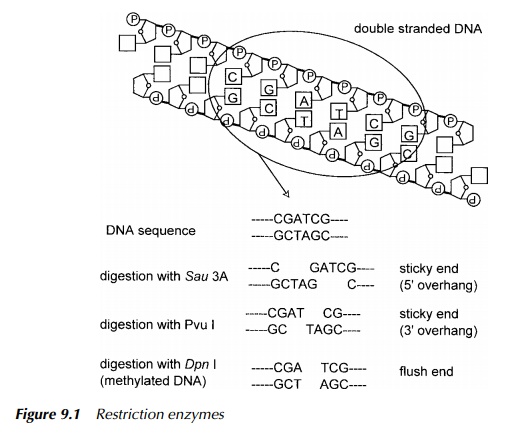Chapter: Environmental Biotechnology: Genetic Manipulation
Enzymes, solutions and equipment - Basic Principles of Genetic Engineering
Basic Principles of Genetic Engineering
There are endless permutations of the basic cloning procedures but they all share some fundamental requirements. These are: the enzymes, solutions and equipment necessary to perform the procedures; the desired piece of DNA to be transferred; a cloning vector; and the recipient cell which may be a whole organism. For the process to be of any measurable value, it is also essential to have some means of determining whether or not the transfer has been successful. This is achieved by the use of marker genes. The requirements referred to above are described in the following sections.
Enzymes, solutions and equipment
There are many steps involved in the isolation of DNA which now have become standard laboratory techniques. Once DNA has been isolated from an organism, it is purified from contaminating material such as protein and is precipitated out of aqueous solution by the addition of alcohol, for example ethanol, to approximately 70%. The DNA appears as a white, semi-transparent material, coiling out of solution on addition of the alcohol. This may be collected by centrifugation and dried down ready for the next stage which is usually enzyme digestion. The aim of the next stage is to insert the DNA into the vector, for which the ends of the DNA and the vector have to be prepared. This may be done by restriction endonucleases which recognise specific sequences within the DNA and cut at that site, either producing a flush or staggered end, Figure 9.1, or by incubation

over a very limited time period with an exonuclease which digests the end of the DNA and followed by further digestion with another nuclease which tidies up the ends to produce flush ends. There are other restriction nucleases which recognise a site in DNA but cut at some distance from it, but these are rarely of any value in cloning procedures.
Preparation of the vector is dictated by the type of end prepared for the insert DNA: flush or ‘sticky’. If it is flush, it does not much matter how that was achieved so long as the vector receiving it is also flush, but if it is sticky, the appropriate sticky end must be prepared on the vector by a suitable restric-tion endonuclease. There are many methods of DNA and vector preparation all of which have their advantages and disadvantages.
Having prepared the ends, the next step is to stick the pieces together. The prepared insert, or ‘foreign’ DNA is incubated with the prepared vector in an aqueous solution containing various salts required by the enzymes, and ligase which is an enzyme, the function of which is to make the bond between the free phosphate on a nucleotide base and the neighbouring ribose sugar, thus ‘repairing’ the DNA to make a complete covalently linked chain. This recombinant DNA molecule may be transferred into a cell where it undergoes replication in the usual way. If the DNA is not viral, introduction will be by direct entry through the cell membrane achieved by any one of a number of standard techniques all based on making the membrane permeable to the DNA molecule. However, if the ‘foreign’ DNA is part of a recombinant virus, it has to be packaged into particles, and then transferred into cells by infection. A check may be made on the product by carrying out analyses described later.
Related Topics